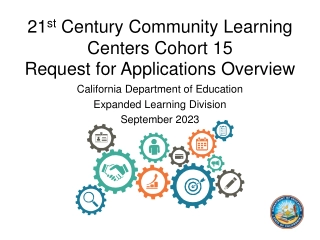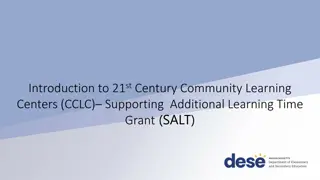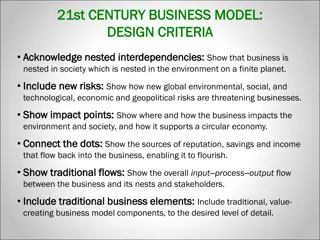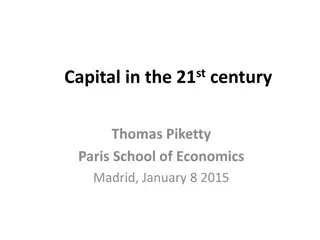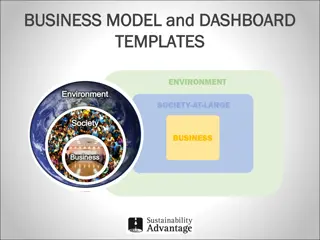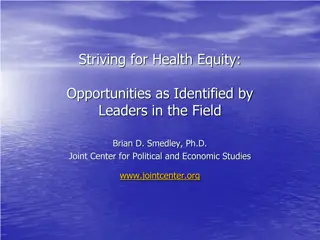Global Health Challenges and Opportunities in the 21st Century
Unpacking the Sustainable Development Goals (SDGs), this content touches on important thresholds in global health, the impact of redefined priorities, the progress made since the MDGs, the rising burden of non-communicable diseases, lessons learned from the Ebola crisis, and challenges posed by urbanization. Emphasis is placed on the need for resilient health systems, enhanced disease surveillance, and increased investment in research and development to address current and emerging global health issues.
Download Presentation

Please find below an Image/Link to download the presentation.
The content on the website is provided AS IS for your information and personal use only. It may not be sold, licensed, or shared on other websites without obtaining consent from the author.If you encounter any issues during the download, it is possible that the publisher has removed the file from their server.
You are allowed to download the files provided on this website for personal or commercial use, subject to the condition that they are used lawfully. All files are the property of their respective owners.
The content on the website is provided AS IS for your information and personal use only. It may not be sold, licensed, or shared on other websites without obtaining consent from the author.
E N D
Presentation Transcript
ICE March 2016 Unpicking SDG s Part 2 Session 5
Health 3 important thresholds They have redefined global health problems and priorities as more broad-based and inclusive; By reprioritising the global health agenda, they may divert funding from some global health organizations and initiatives; and They have laid out new norms, principles, and institutions for dealing with global health challenges
Delivering better health care Preventative more teachers than doctors Women s Health - http://www.womendeliver.org/knowledge- center/publications/invest-in-girls-and-women-everybody-wins-2014/ Since 1990 we have seen unprecedented progress in improving global health outcomes, thanks in part to the priority given to health in the MDGs (3 out of 8 MDGs were focused on health). A 47% reduction in maternal mortality, and a 49% reduction in child mortality are just two of the extraordinary achievements of the past generation.
Other factors Strong, resilient and equitable systems that enable all people to live healthy lives are required at country level the global health architecture should be rethought in a way that best supports the building of these systems. A fundamental shift affecting global health is the rising burden of non-communicable diseases (NCDs). The ageing of the population a key driver in the rise of NCDs represents a significant challenge to global health. Low-income and lower-middle-income countries that are still battling infectious diseases are faced with a double burden of disease that in many cases overstretches already weak health systems
Lessons from Ebola The recent Ebola crisis in West Africa has shown that weak health systems make countries more vulnerable, and underscores the importance of strengthening these systems to protect global health security. There is a need for enhanced global disease surveillance and detection capacities, as well as improved international coordination in responding to emerging health threats Global health funders must continue to explore how their strategies can address the rising challenges of poor populations and pockets of high disease burden in middle-income countries. Supporting fragile states more effectively will also be critical in the SDG era, as their populations are disproportionally affected by major health problems. Insufficient financing and weak incentives currently exist for investment in research and development (R&D) to tackle neglected and poverty-related diseases. Expanding R&D financing and the range of incentives for investing in R&D is a priority area for action
Urbanisation just a few considerations Urban areas are expanding faster than urban populations. If current trends continue, between 2000 and 2030 urban land cover is expected to triple, while urban populations are expected to nearly double. Most of the growth is expected to happen in small and medium-sized cities, not in megacities. Urban areas modify their local and regional climate through the urban heat island effect and by altering precipitation patterns, which together will have significant impacts on local and regional net primary production, biodiversity and ecosystem functions. Urban expansion will heavily draw on natural resources, including water, on a global scale, and will often consume prime agricultural land, with knock-on effects on biodiversity and ecosystem services elsewhere
Urbanisation - 2 Urban land expansion is occurring rapidly in areas adjacent to biodiversity hotspots, and faster in low-elevation, biodiversity-rich coastal zones than in other areas. Future urban expansion will mainly occur in regions of limited economic and institutional capacity, which will constrain management of biodiversity and ecosystem services. Half the increase in urban land across the world over the next 20 years will occur in Asia, with the most extensive patterns of change expected to take place in India and China Sustainability Issues
Climate Change Climate change is a major challenge and it sits among many other major challenges targeted by the post-2015 development goals. Biodiversity, health, education, energy and others influence and are influenced by climate change. So goals about them will also mean action on climate change. Development goals that focus on the root causes of sustainability challenges bring people together; they also minimise the risk that goals will interfere with each other. But highlighting a single environmental driving factor such as climate change can be counterproductive. Climate change action is usually separated into two categories, despite continual calls for merging them. The first is mitigation , which refers to reducing emissions and increasing the removal of greenhouse gases. The second is adaptation , which means reducing climate change s adverse impacts and exploiting its positive impacts
Climate Change mitigation is addressed through Goals 7 on energy, 12 and 14 on resources, and 15 on land use, among others. Achieving sustainable resource management and preventing pollution necessarily means reducing fossil fuel dependency while increasing energy efficiency. And a goal to reduce all pollution, by definition, tackles greenhouse gases. Within pollution-prevention goals (such as 6 and 14), quantitative targets could be developed for a long list of specific emissions, including those associated with climate change. Having a goal that selects only one, such as carbon dioxide or carbon dioxide equivalent, excludes many persistent organic pollutants and smog contributors. Similarly, growing and protecting trees is important for mitigation. But considering all ecosystems together as done by the goals on water, resources and land use is more effective because it gives people sustainable livelihoods based on using natural resources without harming ecosystems. That addresses the root causes of sustainability problems and must necessarily achieve mitigation without excluding people or sacrificing other ecosystems for forests.
Climate Change Adaptation involves actions such as managing waterways to avoid extreme floods and droughts, protecting built heritage sites against freeze-thaw cycles and helping people who cannot afford temperature control inside their homes to survive hot and cold spells. Such actions are needed irrespective of climate change. And such actions were indeed being implemented as part of disaster risk reduction for all hazards long before climate change became a major concern. If goals seek reduced disaster risk across all hazards, including climate-related ones, then adaptation is incorporated by definition For instance, rather than proposed Goal 13.1 being to strengthen resilience and adaptive capacity to climate induced hazards and natural disasters in all countries , it could say strengthen disaster risk reduction in all countries . If development goals aim for adaptation only, without aiming for disaster risk reduction across all hazards, then resilience cannot be achieved.
Climate Change some practical considerations What does this mean in practical terms? Hospitals ought to be built outside floodplains that are likely to expand due to climate change. But they could still collapse in the next earthquake so they should be multi-hazard resilient, not just adapted to climate change. That requires goals encompassing, but extending beyond, adaptation. Governments need to plan sensibly against the obvious problems shown above. Let s consider the broad reactions
Climate Changes the facts Climate change makes existing problems much much worse Imagine different global challenges as fires burning issues like poverty, conflict, refugees, environmental degradation, biodiversity loss and natural disasters. Adding climate change into the mix is like throwing petrol on all of those fires making them burn faster and making them much harder to control. The impacts of climate change depend on the level of warming The impacts of climate change are already being felt. But they become much worse the hotter it gets! This is why many are calling for governments to keep global warming well below 1.5 degrees. Climate change is impacting the poorest first and worst The poorest people have done the least to cause climate change in the first place. But they are feeling the brunt of its impacts because they often depend directly on natural resources for their livelihoods, have the least ability to respond to climate change and often live in more marginal areas.
Climate Change the facts We are all, rich and poor, being impacted by climate change Although climate change has the biggest impact on the poor it affects everyone. Climate change is not a future problem it is a current problem. Effects are happening now: changes to weather patterns, sea level rises, changes to the distribution of plant and animal species, reduced access to water, and social impacts like food prices, increased conflict and migration We all have a responsibility to tackle climate change and support those impacted by climate change This needs to be reflected in the lifestyle choices we make, the actions of our leaders and the financial commitments from the UK government Like many aspects of poverty, climate change is a political and economic problem Climate change is often portrayed as an environmental problem. But actually it is the result of how our economies are structured and fuelled. And responding to those challenges requires political and economic solutions
Thats it vast topic!! Please stay in touch, I will always respond to emails Birchall.john68@gmail.com



